GEEKOM A5 mini-PC Review: Affordable Cezanne Zen 3 at 35W
by Ganesh T S on December 8, 2023 9:15 AM ESTSystem Performance: Miscellaneous Workloads
Standardized benchmarks such as UL's PCMark 10 and BAPCo's SYSmark take a holistic view of the system and process a wide range of workloads to arrive at a single score. Some systems are required to excel at specific tasks - so it is often helpful to see how a computer performs in specific scenarios such as rendering, transcoding, JavaScript execution (web browsing), etc. This section presents focused benchmark numbers for specific application scenarios.
3D Rendering - CINEBENCH R23
We use CINEBENCH R23 for 3D rendering evaluation. R23 provides two benchmark modes - single threaded and multi-threaded. Evaluation of different PC configurations in both supported modes provided us the following results.
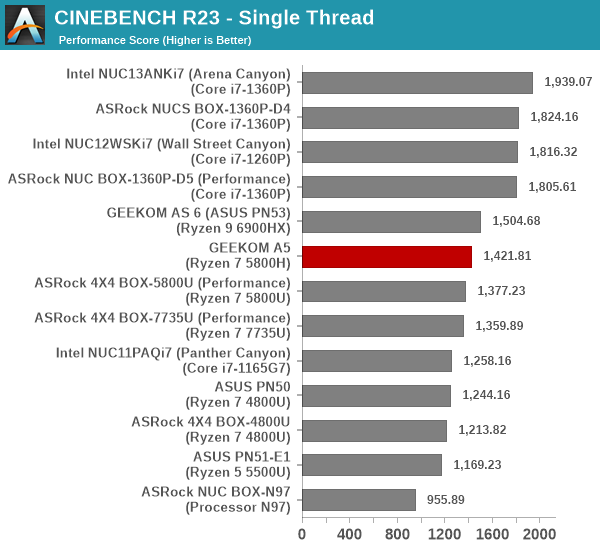
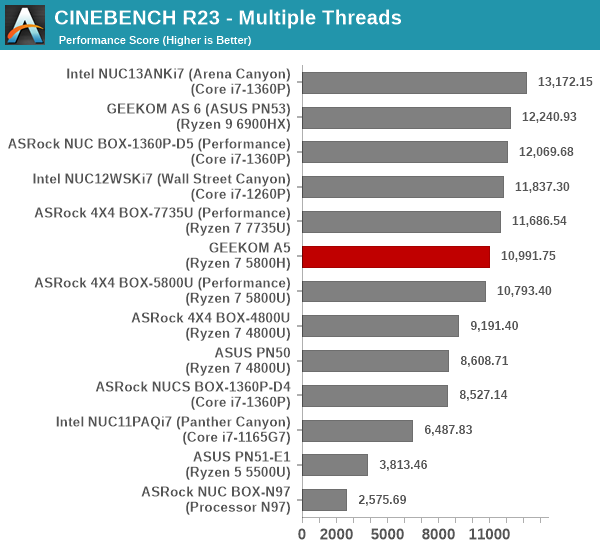
The GEEKOM A5 performs similar to the other Cezanne system in the list, and there are no other surprises. The combination of a 35W cTDP and the processor generation mean that the system slots right in the middle in both operating modes.
Transcoding: Handbrake 1.5.1
Handbrake is one of the most user-friendly open source transcoding front-ends in the market. It allows users to opt for either software-based higher quality processing or hardware-based fast processing in their transcoding jobs. Our new test suite uses the 'Tears of Steel' 4K AVC video as input and transcodes it with a quality setting of 19 to create a 720p AVC stream and a 1080p HEVC stream.

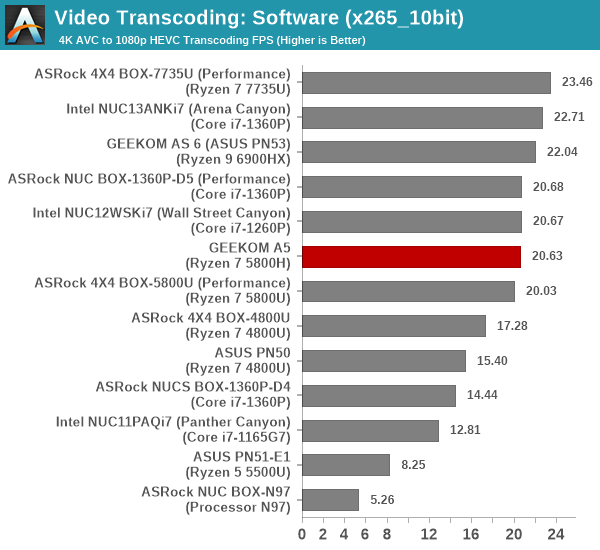
Software transcoding performance depends on the number of available threads and the available power budget, even when the comparison is across different processor generations. Similar to the 3D rendering workload, the A5 makes its mark in the middle of the pack.
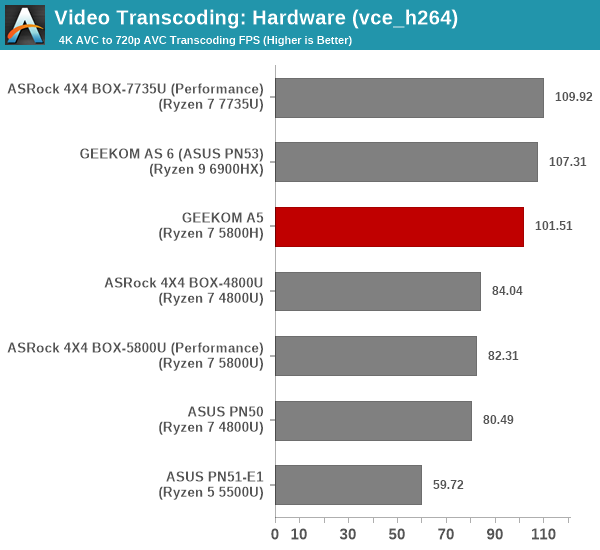

Hardware transcoding performance using VCE depends on the iGPU clock rates, which in turn depends on the available power budget for long-term tasks. The A5 has a slight edge in the power budget over the other Cezanne system, and that shows up as a significant delta in the FPS numbers for VCE processing. Other than that, it is easy to note that the numbers improve with newer iGPU generations.
Archiving: 7-Zip 21.7
The 7-Zip benchmark is carried over from our previous test suite with an update to the latest version of the open source compression / decompression software.
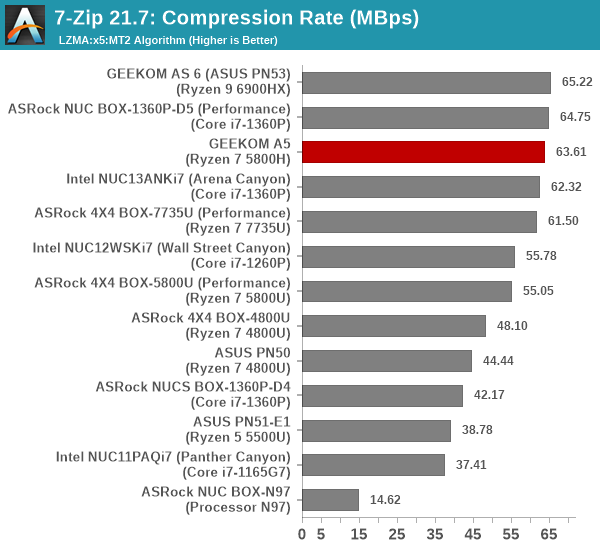

The Cezanne SoC packs 8 high-performance Zen 3 cores, and has an edge over Intel-based processors for multi-threaded workloads like compression and decompression. That is reflected in the scores above, with the A5 being bettered only by systems sporting SoCs with Zen 3+ cores.
Web Browsing: JetStream, Speedometer, and Principled Technologies WebXPRT4
Web browser-based workloads have emerged as a major component of the typical home and business PC usage scenarios. For headless systems, many applications based on JavaScript are becoming relevant too. In order to evaluate systems for their JavaScript execution efficiency, we are carrying over the browser-focused benchmarks from the WebKit developers used in our notebook reviews. Hosted at BrowserBench, JetStream 2.0 benchmarks JavaScript and WebAssembly performance, while Speedometer measures web application responsiveness.
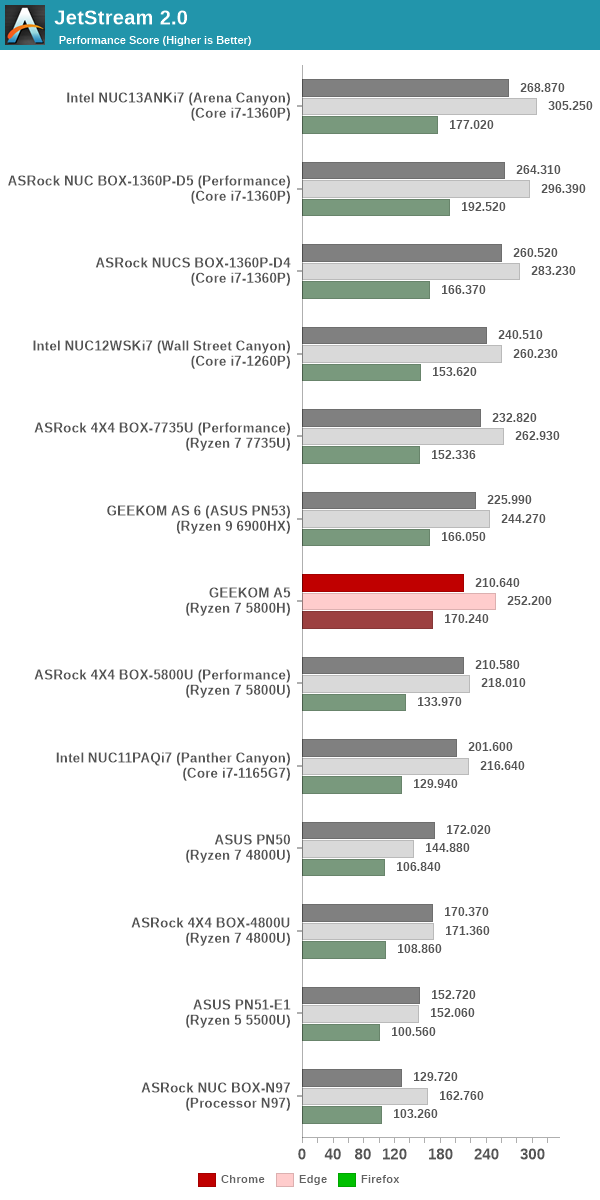
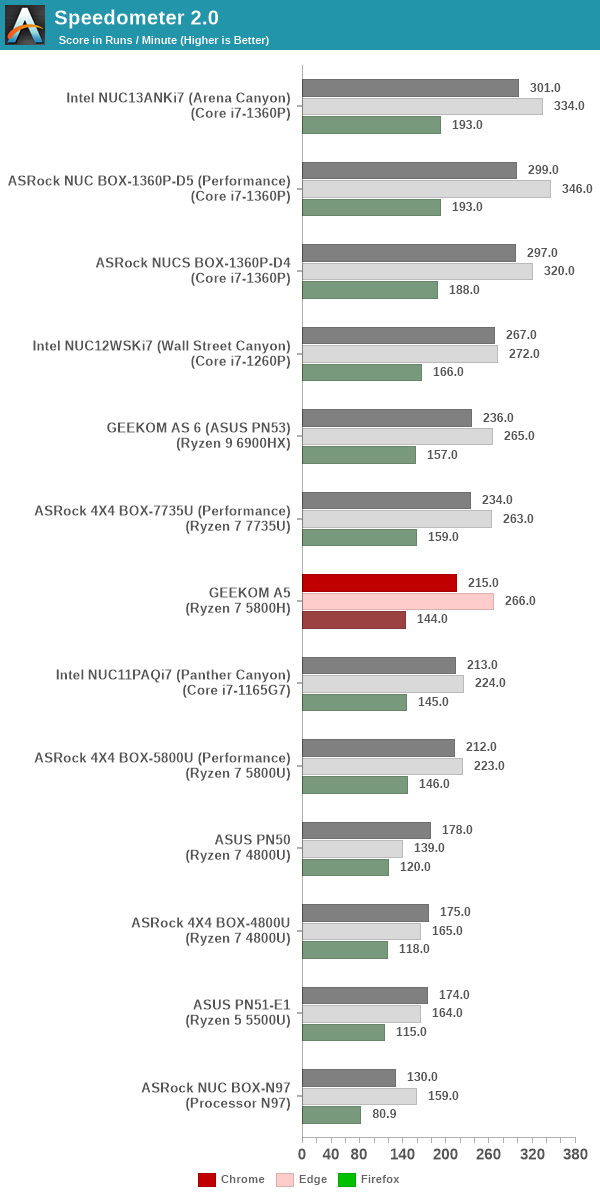
From a real-life workload perspective, we also process WebXPRT4 from Principled Technologies. WebXPRT4 benchmarks the performance of some popular JavaScript libraries that are widely used in websites.
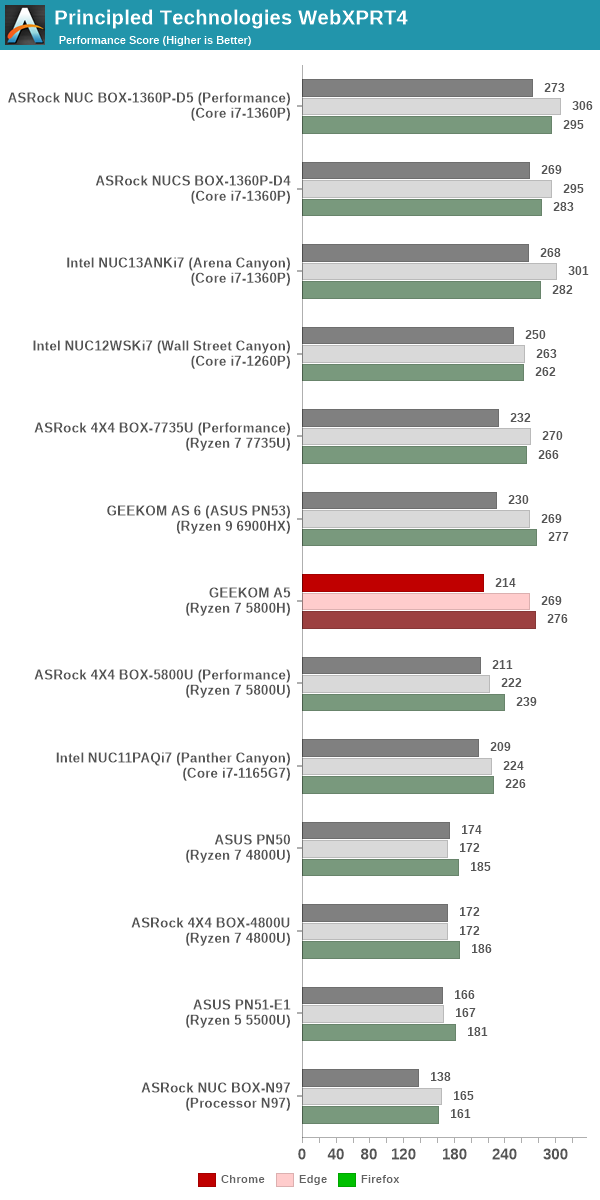
All the web browsing benchmarks see the A5 land in the middle of the pack around the same spot as the other Cezanne system in the list. These tests bring out the single-threaded performance capability, and the Intel-based systems have a slight edge in each generation. Short bursts of high clock speeds help a bit, particular for the real-world simulating WebXPRT4 benchmark.
Application Startup: GIMP 2.10.30
A new addition to our systems test suite is AppTimer - a benchmark that loads up a program and determines how long it takes for it to accept user inputs. We use GIMP 2.10.30 with a 50MB multi-layered xcf file as input. What we test here is the first run as well as the cached run - normally on the first time a user loads the GIMP package from a fresh install, the system has to configure a few dozen files that remain optimized on subsequent opening. For our test we delete those configured optimized files in order to force a ???fresh load??? every second time the software is run.
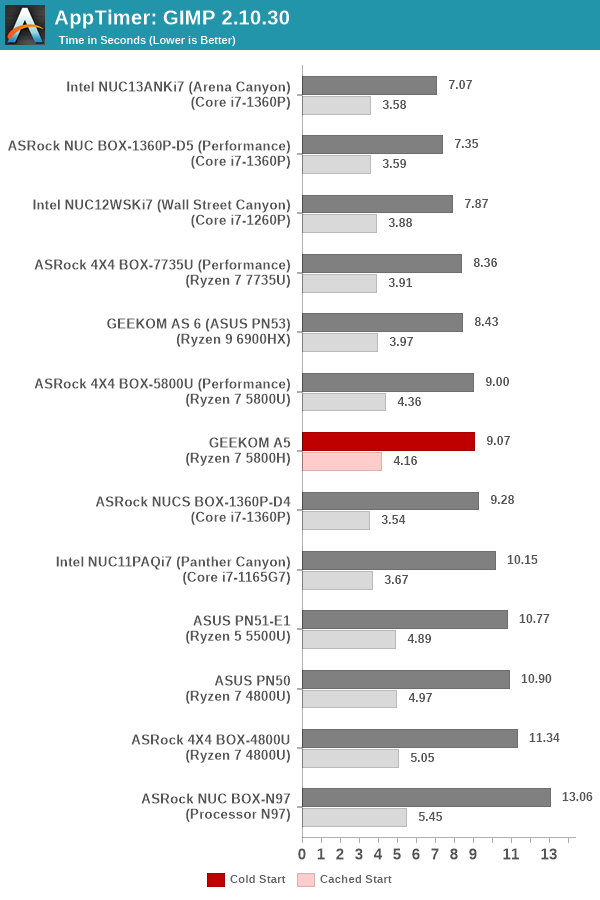
As it turns out, GIMP does optimizations for every CPU thread in the system, which requires that higher thread-count processors take a lot longer to run. So the test runs quick on systems with fewer threads, however fast cores are also needed. The performance is essentially equivalent to the ASRock Industrial's Cezanne system we evaluated back in 2021.
Cryptography Benchmarks
Cryptography has become an indispensable part of our interaction with computing systems. Almost all modern systems have some sort of hardware-acceleration for making cryptographic operations faster and more power efficient. In the case of IoT servers, many applications - including web server functionality and VPN - need cryptography acceleration.
BitLocker is a Windows features that encrypts entire disk volumes. While drives that offer encryption capabilities are dealt with using that feature, most legacy systems and external drives have to use the host system implementation. Windows has no direct benchmark for BitLocker. However, we cooked up a BitLocker operation sequence to determine the adeptness of the system at handling BitLocker operations. We start off with a 4.5GB RAM drive in which a 4GB VHD (virtual hard disk) is created. This VHD is then mounted, and BitLocker is enabled on the volume. Once the BitLocker encryption process gets done, BitLocker is disabled. This triggers a decryption process. The times taken to complete the encryption and decryption are recorded. This process is repeated 25 times, and the average of the last 20 iterations is graphed below.

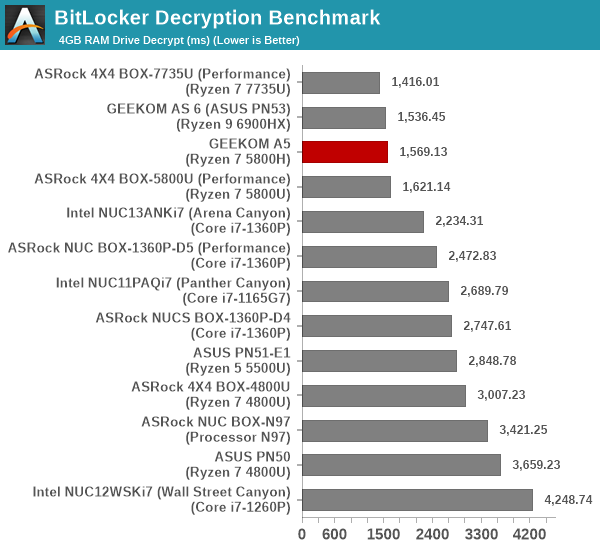
Hardware acceleration is available for the operations in all of the systems. The time taken for processing is directly dependent on the number of cores and available power budget. It must be noted that the AMD-based systems enjoying a distinct advantage over the Intel ones in this department, and it is no surprise to see the A5 in the top 3, bettered only by systems with Zen 3+ cores.










35 Comments
View All Comments
t.s - Friday, December 15, 2023 - link
Yes. Inferior, yet pricier than AMD counterpart.sjkpublic@gmail.com - Saturday, December 9, 2023 - link
All I see here is outdated hardware. Gen3 and not Gen4 or better. No USB 4. Etc. Great unit if you are placing it in a Mall display.FWhitTrampoline - Sunday, December 10, 2023 - link
An ASRock X300 Desk Mini with an STX/AM4 MB and Ryzen 5700G can be had for a little over $320 and the X300 Desk Mini comes with 2, M.2 x4 PCIe link slots and space for 2 SATA internal SSDs. And one of the M.2 slots can be fitted with an M.2 to OCuLink adapter and there's plenty of Knockouts on the X300 Desk Mini's case to rout the OCuLink cable out of the case easily sans any need to open the case afterwards. So with Knockouts on the case for an optional OEM 2 USB port kit or other knockout some OCuLink port could be retrofitted is one gets creative!Reflex - Monday, December 11, 2023 - link
As an owner of a MiniITX board with a 5700G I regret to inform you that external PCIe lanes only run at x3 with that CPU, even for storage. So while on paper that X300 looks better than this mini box, in practice it's got the same limitation. The 5700G is overall not quite as powerful as this mini box at equivalent wattages, although thanks to being an ITX sysem I run mine at 65W which likely outperforms this box substantially.FWhitTrampoline - Tuesday, December 12, 2023 - link
The M.2 PCIe Lanes on processor side of the Board is listed as PCIe 3.0 X4 lanes while the M.2 on back side of the MB limited to what's listed so not according to ASrock's specifications page for the X300 Desk Mini:- 2 x SATA 6Gb 2.5-inch 7mm/9.5mm Hard Drive (RAID 0/1)
- 1 x Ultra M.2 (2280) PCIe Gen3 x4 SSD Slot
- 1 x Ultra M.2 (2280) Slot
- PCIe Gen3 x4 (Renoir, Picasso and Raven Ridge APU)
- PCIe Gen3 x2 (Athlon 2xxGE series APU)
t.s - Friday, December 15, 2023 - link
And what Gen3 that not enough for you that you have to use Gen4? As for USB4, I agree. And you can get it if you buy mini-pc with ryzen 6800u/h or 7735H.Schugy - Sunday, December 10, 2023 - link
That non-USB-C PSU brick must be a joke.lmcd - Monday, December 11, 2023 - link
Depending on your USB controller as part of the lone source of power is an anti-feature in my opinion. With laptops it's different because there's a battery, but USB-C desktop power is a "no thanks."meacupla - Monday, December 11, 2023 - link
It's a standard, and really cheap, 19V laptop power brick.Finding a cheap USB-C charger than can output >120W over a single port is a challenge, unfortunately. Most of them top out at 100W per port.
200W and 240W PD cables have been available for at least 6 months, but no such charger has shown up yet.
stephenbrooks - Monday, December 11, 2023 - link
The brick is nearly as large as the PC.